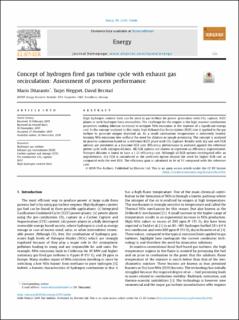| dc.contributor.author | Ditaranto, Mario | |
| dc.contributor.author | Heggset, Tarjei | |
| dc.contributor.author | Berstad, David Olsson | |
| dc.date.accessioned | 2020-03-20T11:13:44Z | |
| dc.date.available | 2020-03-20T11:13:44Z | |
| dc.date.created | 2019-12-09T11:25:14Z | |
| dc.date.issued | 2019 | |
| dc.identifier.issn | 0360-5442 | |
| dc.identifier.uri | https://hdl.handle.net/11250/2647797 | |
| dc.description.abstract | High hydrogen content fuels can be used in gas turbine for power generation with CO2 capture, IGCC plants or with hydrogen from renewables. The challenge for the engine is the high reactive combustion properties making dilution necessary to mitigate NOx emissions at the expense of a significant energy cost. In the concept analysed in this study, high Exhaust Gas Recirculation (EGR) rate is applied to the gas turbine to generate oxygen depleted air. As a result combustion temperature is inherently limited, keeping NOx emissions low without the need for dilution or unsafe premixing. The concept is analysed by process simulation based on a reference IGCC plant with CO2 Capture. Results with dry and wet EGR options are presented as a function EGR rate. Efficiency performance is assessed against the reference power cycle with nitrogen dilution. All EGR options are shown to represent an efficiency improvement. Nitrogen dilution is found to have a 1.3% efficiency cost. Although all EGR options investigated offer an improvement, dry EGR is considered as the preferred option despite the need for higher EGR rate as compared with the wet EGR. The efficiency gain is calculated to be of 1% compared with the reference case. | en_US |
| dc.language.iso | eng | en_US |
| dc.publisher | Elsevier | en_US |
| dc.rights | Navngivelse 4.0 Internasjonal | * |
| dc.rights.uri | http://creativecommons.org/licenses/by/4.0/deed.no | * |
| dc.title | Concept of hydrogen fired gas turbine cycle with exhaust gas recirculation: Assessment of process performance | en_US |
| dc.type | Journal article | en_US |
| dc.type | Peer reviewed | en_US |
| dc.description.version | publishedVersion | en_US |
| dc.rights.holder | The Authors | en_US |
| dc.source.pagenumber | 116646 | en_US |
| dc.source.volume | 192 | en_US |
| dc.source.journal | Energy | en_US |
| dc.identifier.doi | 10.1016/j.energy.2019.116646 | |
| dc.identifier.cristin | 1758163 | |
| dc.relation.project | Norges forskningsråd: 268369 | en_US |
| cristin.unitcode | 7548,70,0,0 | |
| cristin.unitcode | 7548,60,0,0 | |
| cristin.unitname | Termisk energi | |
| cristin.unitname | Gassteknologi | |
| cristin.ispublished | true | |
| cristin.fulltext | original | |
| cristin.qualitycode | 2 | |

